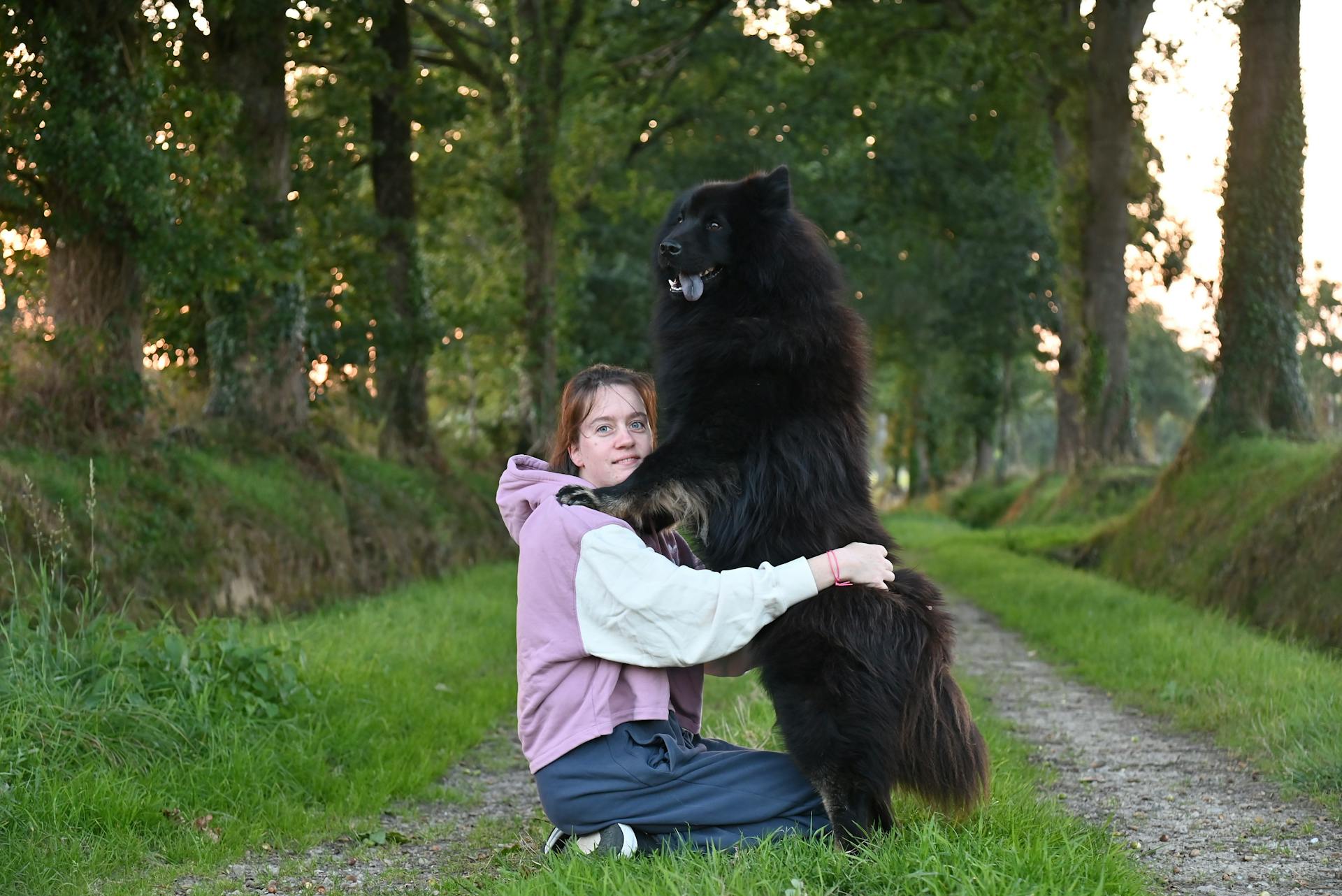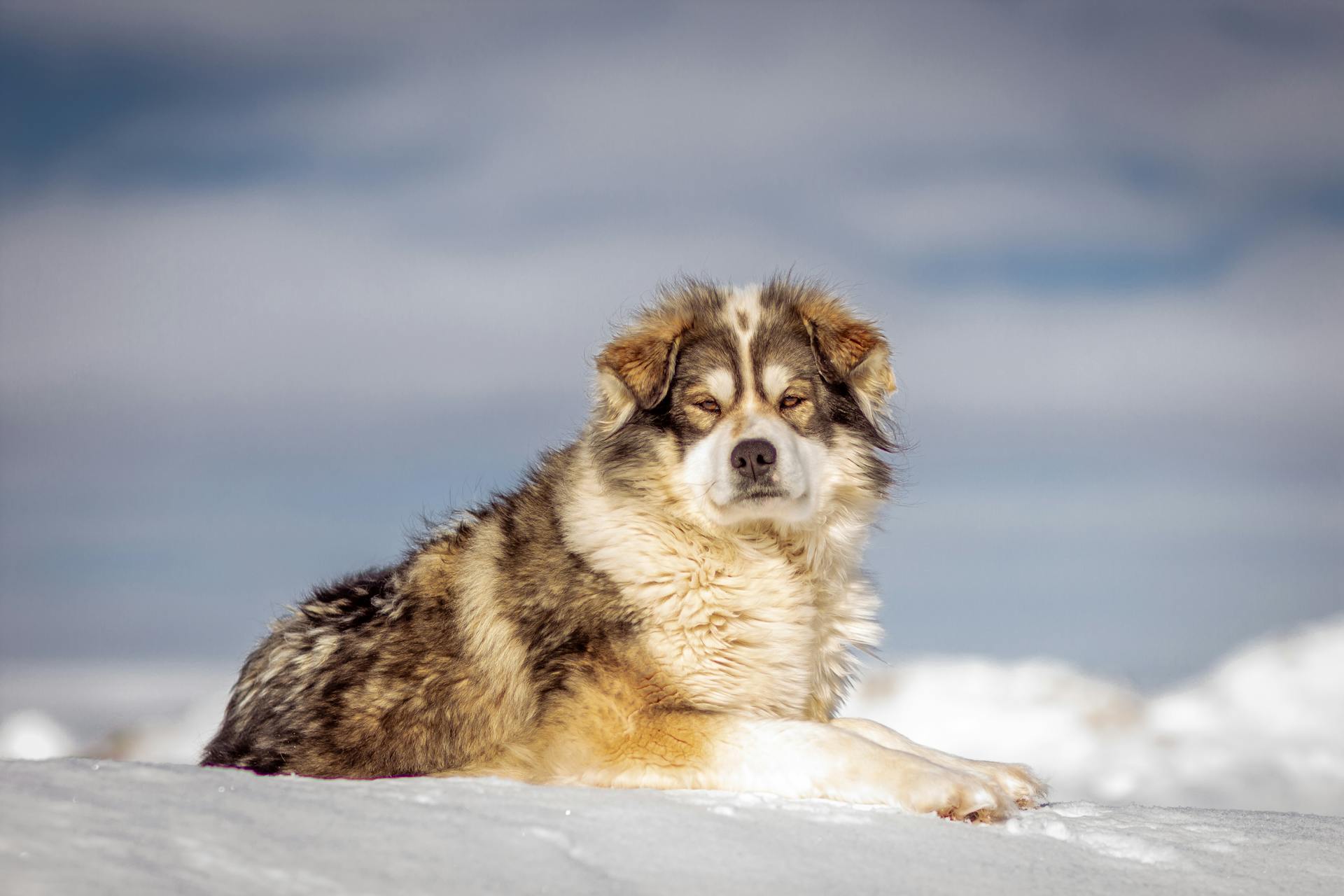
The Spanish Mastiff is a majestic breed known for its impressive size and gentle nature. Originating from Spain, this ancient dog breed has a rich history dating back to the 15th century.
The Spanish Mastiff is a massive dog, with males weighing between 160 and 230 pounds and standing as tall as 30 inches at the shoulder. They are a large breed that requires plenty of space to move around.
Despite their massive size, Spanish Mastiffs are known for being calm and gentle, making them great family pets. They are also loyal and protective of their families, but they are not generally aggressive.
Check this out: Giant Husky Malamute
Care and Nutrition
Spanish Mastiffs need sufficient room for daily exercise, but they're not high-energy breeds. They require about an hour of exercise every day, which can include a long walk, swim, or playtime in the house or a fenced yard.
Their grooming requirements are fairly straightforward, but training and socialization should receive extra attention to ensure that the dog is friendly and well-mannered. Obedience training should be pursued when a Spanish Mastiff is young, so they grow into a well-mannered dog.
To prevent excess weight gain, be mindful of treats and other extra food. A Spanish Mastiff might benefit from a dog food that's formulated for large breeds, and it's typical to feed two measured meals per day to ensure that your dog is getting the correct amount.
Here's a rough estimate of the daily calorie needs for a Spanish Mastiff:
Remember to discuss the type of food and the amount with your veterinarian to ensure you're feeding your Spanish Mastiff the best.
Diet and Nutrition
Fresh water should always be available for your Spanish mastiff.
Feed your Spanish mastiff a quality, nutritionally balanced canine diet, and consider a dog food formulated for large breeds to ensure proper nutrition.
Two measured meals per day are typical, but your veterinarian may recommend a different feeding schedule based on your dog's individual needs.
Be mindful of treats and other extra food to prevent excess weight gain, which can put too much stress on your dog's joints.
A joint supplement and an omega-3 fatty acid supplement (fish oil) may be recommended by your veterinarian to support your dog's joints, especially if your dog weighs over 140 pounds.
Talk to your veterinarian before giving any supplements to your dog.
To minimize the risk of bloat or GDV, feed your dog two or three smaller meals a day, instead of one large meal.
Avoid using elevated food bowls, and don't exercise your dog one hour before to one hour after a meal.
Measure out meals, and don't overfeed your dog, as obesity can cause arthritis to develop within their joints early in life and lead to chronic mobility issues.
Here are some estimated daily calorie needs for Spanish mastiffs based on their activity level:
Remember to consult with your veterinarian to determine the correct portion size for your Spanish mastiff based on their ideal body weight, life stage, and health.
Grooming
Grooming is an essential part of Spanish Mastiff care. The breed doesn't require a professional groomer, but regular brushing is necessary to prevent matting.
Weekly brushing with a pin brush and comb is recommended, especially during mild shedding periods. A deshedding rake should be used once or twice a week during heavy shedding seasons, which occur in the spring and fall.
The Spanish Mastiff sheds year-round, with heavier shedding in the spring and fall. This means you'll need to brush your dog more frequently during these seasons to minimize the amount of fur shed indoors.
You'll also need to clean your dog's ears occasionally and trim their nails as needed. Some working Spanish Mastiffs may wear down their nails in the field, but this isn't always the case.
Spanish Mastiffs are huge droolers, especially after exertion, eating, or drinking. If you let your dog in the house, consider keeping drool rags handy, preferably made of leather or faux leather, which are easier to clean and dry than cloth fabrics.
Here's a brief guide to Spanish Mastiff grooming:
- Brush your dog weekly with a pin brush and comb
- Use a deshedding rake during heavy shedding seasons
- Clean your dog's ears occasionally
- Trim their nails as needed
- Keep drool rags handy, preferably made of leather or faux leather
Training and Behavior
Training a Spanish Mastiff requires patience and consistency. Positive-reinforcement training methods work best, making training sessions fun and varied.
Start training and socialization when your puppy is young, ideally in a puppy class. This will help teach basic commands and manners.
A Spanish Mastiff's size can make it challenging to manage if it hasn't been well-trained. Early socialization and training are crucial to prevent this.
Socialization is key to exposing your Spanish Mastiff to various people and other dogs from an early age. This will help your dog view strangers as non-threatening.
A Spanish Mastiff is not known to be anxious or fearful, but it will become alert when a stranger or unfamiliar animal is nearby.
Their bark is low-pitched and deep, and can be heard from a distance. They may bark to alert loved ones of a possible threat, even if it's just a delivery person.
Because of their independent nature, Spanish Mastiffs can be difficult to train. People with more experience training dogs are better equipped to train a Spanish Mastiff.
Take a look at this: When Do Mastiffs Stop Growing
Obedience training classes should start when your dog is young, and positive reinforcement is essential. If needed, seek a professional dog trainer.
A Spanish Mastiff's loyalty and devotion to its family make it a wonderful protector of its home and family. Consistent and firm training is necessary to establish the dog's respect as a leader.
With proper training and socialization, a Spanish Mastiff can be an extremely loyal pet. Supervised exposure to unfamiliar dogs in puppyhood can help dampen aggression towards other dogs.
Health and Wellness
The Spanish Mastiff is a generally healthy breed, but like all dogs, it can face common health concerns as it ages, such as arthritis.
As a giant breed, Spanish Mastiffs are prone to elbow and hip dysplasia, which can lead to pain and lameness if not addressed.
Their large size also means they need to be fed carefully to avoid growing too quickly, which can cause musculoskeletal problems as adults.
Spanish Mastiffs can live for 10-12 years on average, and during that time, they may develop a handful of medical conditions.
Hip dysplasia is a particular concern for Spanish Mastiffs, with the Traditional Spanish Mastiff having a lower prevalence of the disease than the official variety.
Explore further: Bernese Mountain Dog Hip Dysplasia
Health Issues

Spanish Mastiffs are generally a healthy breed, but like all dogs, they can face common health concerns as they age, such as arthritis.
As a giant breed, Spanish Mastiffs are prone to elbow and hip dysplasia, which can lead to pain and lameness if not properly managed.
Breathing problems, entropion, and heart troubles are also potential concerns for this breed.
With their large size, it's essential to be cautious with feeding to prevent rapid growth, which can cause musculoskeletal problems later in life.
Spanish Mastiffs may take about 4 years to reach full size, so patience is key to preventing these issues.
The average Spanish Mastiff lifespan is 10-12 years, and they can develop a handful of medical conditions over their life.
Hip dysplasia is a significant concern for Spanish Mastiffs, with the Traditional variety having a lower prevalence of the disease than the official variety.
On a similar theme: English Bull Terrier 100 Years Ago
Lifespan and Maturity
Spanish Mastiffs have a relatively short average lifespan of about 10 years, but some individuals can live up to 16 years.
For more insights, see: 100 Years Ago Original Boston Terrier

Their slower growth rate means they may take longer to reach maturity, potentially up to 4 years, compared to other breeds that reach full size and maturity in about 2 years.
This longer maturation period can be a challenge for owners, but with proper care and attention, Spanish Mastiffs can thrive and live fulfilling lives.
Here's an interesting read: Shiba Inu Coin Reach 1 Cent
Appearance and Size
The Spanish Mastiff is a very large and powerful dog, with a serious and vigilant expression. They have a massive head and a compact, powerful build.
Males in this breed are typically 28 to 33 inches tall at the withers, while females are at least 26 inches tall. The ideal Spanish Mastiff is at least 28 inches tall.
One of the most striking features of the Spanish Mastiff is its coat, which can be fawn, brindle, black, or "wolf"-colored. Reddish tones in the coat can indicate miscegenation.
Males can weigh anywhere from 110 to 220 pounds, with females weighing between 88 and 170 pounds. The breed's size has changed significantly over the past 30 years, with older sources listing a height of around 26-28 inches and a weight of 110-132 pounds.
Characteristics
The Spanish Mastiff is a gentle giant, known for its affectionate and easygoing personality around family members. They thrive on attention and love to be around people.
Their temperament is a mixed bag, as they can be wary of strangers and other dogs, which may impact their behavior. This caution is a natural instinct, but it's essential to socialize them well to avoid any potential issues.
One of the best things about Spanish Mastiffs is their low barking tendency. They don't bark excessively, but they will use their deep bark as an alert to perceived threats. This makes them great companions for families who live in noise-restricted areas.
Here's a quick rundown of their temperament:
Their intelligence is average, but they're still highly trainable with patience and consistency. They're not overly playful, but they do need regular exercise to stay happy and healthy.
General Appearance
The Spanish Mastiff is a dog of great size, compact and powerful.

They have a massive head, a semi-long coat, and a balanced and harmonious build which allows them to be extremely functional.
Males in this breed can grow up to 85 centimetres (33 in) tall at the withers.
Females are at least 65 centimetres (26 in) tall, and their weight can range from 40 to 60 kilograms (88 to 132 lb).
The ideal Spanish Mastiff is at least 70 centimetres (28 in) at the withers, and their coat can be most often fawn, but it can also be brindle, black or 'wolf'-coloured.
Size
The Spanish Mastiff is a massive breed, with a significant size difference between older and more recent sources.
Males can reach a height of 30.5 inches minimum, while females are at least 28.5 inches tall.
The breed's weight has also increased, with females weighing between 145-170 lbs and males reaching up to 220 pounds.
In fact, the weight of Spanish Mastiffs has more than doubled in recent years, with older sources listing a weight of 110-132 pounds.
The breed's size has been influenced by its use as a show dog, with larger dogs being bred for the show ring.
Frequently Asked Questions
Is a Spanish Mastiff a good family dog?
Spanish Mastiffs are generally excellent family dogs due to their gentle and patient nature. They make loyal and caring companions for children in the household.
Are Spanish mastiffs good guard dogs?
Yes, Spanish Mastiffs are naturally protective and make excellent guard dogs due to their strong territorial instincts. They can be wary of strangers, making them a reliable choice for security and protection.
Featured Images: pexels.com

